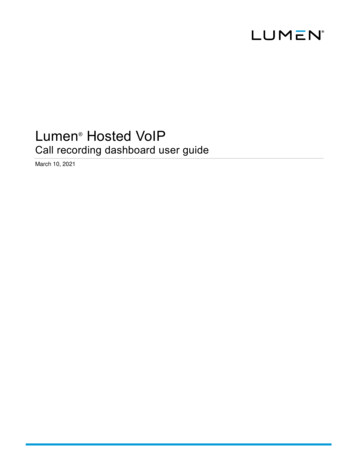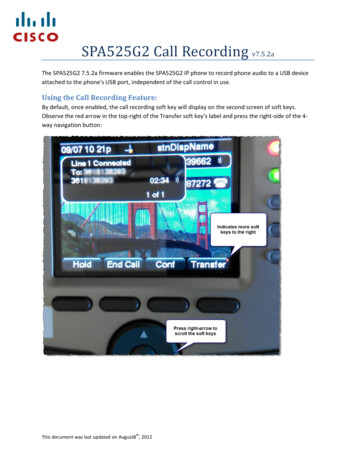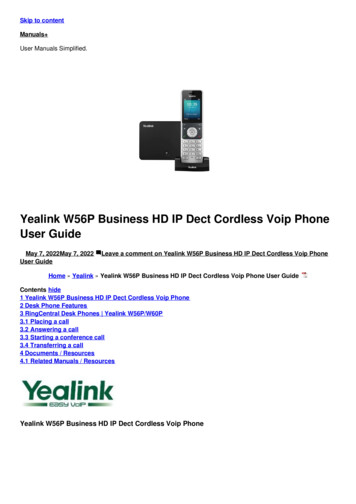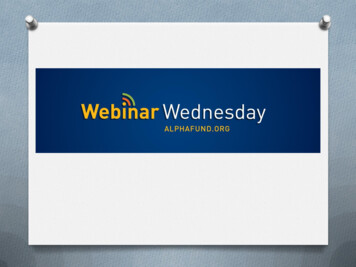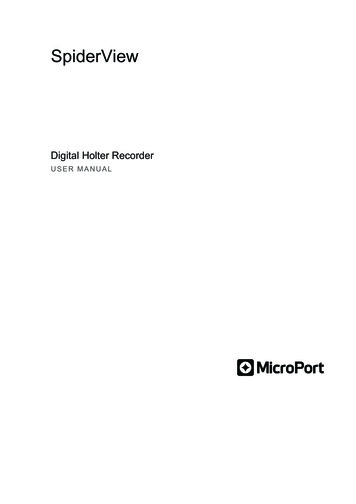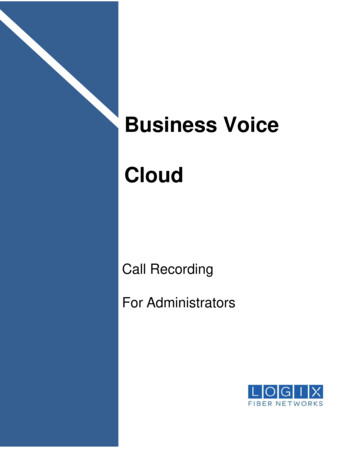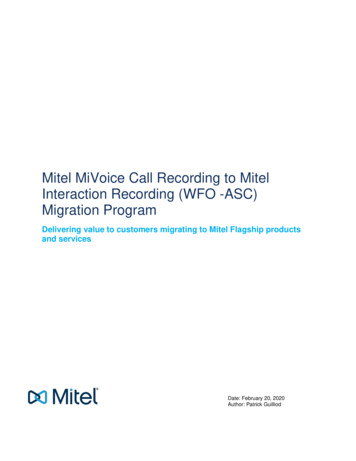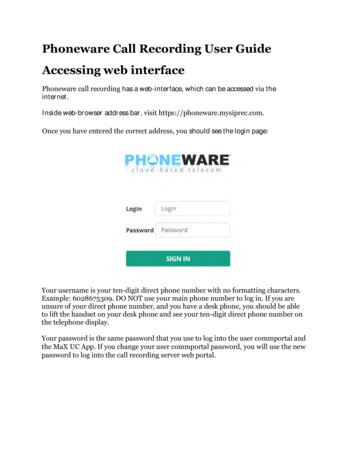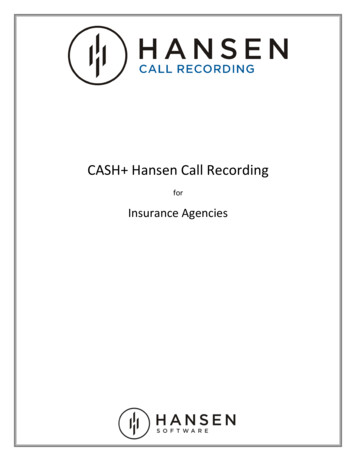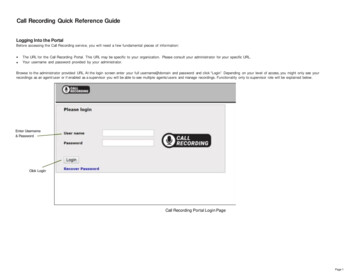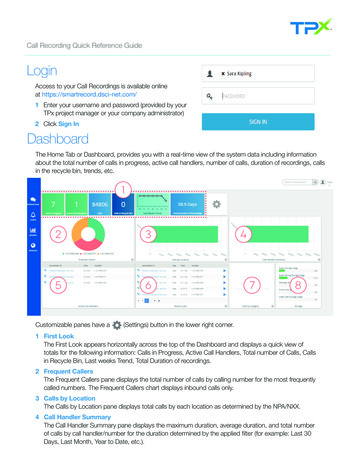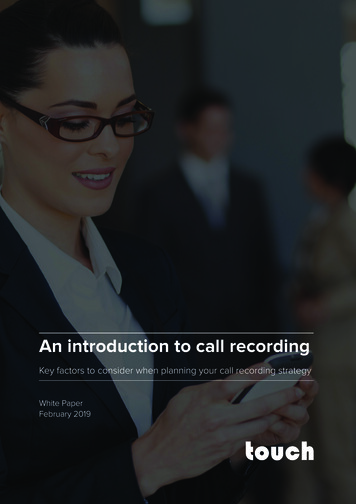
Transcription
An introduction to call recordingKey factors to consider when planning your call recording strategyWhite PaperFebruary 2019
ContentsIntroduction . . . . . . . . . . . . . . . . . . . . . . . . . . 3Call Recording for your business . . . . . . . . . . . . . . . 5What makes a modern call recording solution? . . . . . . . 6Q1: What is the purpose of your call recording? . . . . . 8Q2: How long do you need to store the recordings? . . 8Q3: Do you need consent from the calling party? . . . . 8Q4: How easy is the solution to implement? . . . . . . . 9Q5: How easy is the system to use? . . . . . . . . . . . 9Q6: How secure is the storage system? . . . . . . . . . 9Q7: Do you need a Service Level Agreement? . . . . . 10Q8: Is the solution future-proof? . . . . . . . . . . . . . 10Q9: Can recordings be shared with remote staff? . . . 10Q10: Is it suitable for employee training? . . . . . . . . . 11Q11: Does the system comply with legislation? . . . . . . 11Q12: Do you need to move old recordings? . . . . . . . 12Q13: Does it support open and standard formats? . . . 12Summary . . . . . . . . . . . . . . . . . . . . . . . . . . . 13
AN INTRODUCTION TO CALL RECORDINGIntroductionThe key considerations of call recordingCall recording is not a new practice and has, in fact, beenaround for some time. Law enforcement professionalsbegan using hardware to record telephone calls as earlyas in the 1890s.We’ll explore what call recordingmeans, the key considerations whenmatching organisational requirementsand needs with the availabletechnology, to help guide yourdecision-making process.Recent years have seen significant growth in the adoptionof call recording solutions, as organisations seek to complywith regulatory mandates, enhance staff training anddevelopment, and create a richer set of auditable records,across all sources.As a result, the importance of call recording has grown.Because of this, it’s important to make the right choice whenselecting a solution.We’ll explore what call recording means, the keyconsiderations when matching organisational requirementsand needs with the available technology, to help guide yourdecision-making process.3
OperatorConnectorSecure Storageand ManagementAdministrationPBXRecorderSearch engineCall CentreRecorderStreamingSkypeRecorderLog and traceChatLoggerConfigurationImport andConvertReporting
AN INTRODUCTION TO CALL RECORDINGCall recording for your businessThe challenge of multi-channel call recordingCall recording brings benefits to most companies andorganisations and is practised for a wide number ofreasons, which include:1.Legal or compliance reasons2. Quality assurance and management3. Staff training4. Documenting advisory and transactionsToday’s businesses should try toreplace legacy recording systems thatcannot meet their evolving needs and,instead, choose a modern approach.This means that the call recordingcapability is supplied as a service,spanning all connected channels andbacked by a high-availability SLA.A key challenge for today’s businesses is that many now usemultiple channels to communicate, such as fixed phones,mobile phones, IP phones, Skype for Business, SMS, Chat,and more. As our way of communicating evolves, so doescall recording – but this places many demands on legacysolutions, leaving them no longer fit for purpose.Call Recording for business calls typically used to beimplemented in-house. It started with single source tapesystems, which were later replaced by disk system runningon local hardware. Early systems were used to record callshandled by the office switchboard and telephony system(or PBX). Legacy recording systems also placed additionaldemands on the business, requiring hardware installation,the costs of which are generally very high. This also neededexpert personnel, licenses and the hardware used forrecording and storing the calls.Today’s businesses should try to replace legacy recordingsystems that cannot meet their evolving needs and, instead,choose a modern approach. This means that the callrecording capability is supplied as a service, spanning allconnected channels and backed by a high-availability SLA.5
AN INTRODUCTION TO CALL RECORDINGWhat makes a modern call recording solution?Call Recording as a Service (CRaaS)An effective call recording as a service solutionmust ensure that the recorded calls and other digitalcommunications media should be stored in a private cloudand offer the highest security levels.Before choosing a call recordingsolution for your business, you shouldconsider some key questions.Recordings should be retrievable and accessible via asecure web-portal, through which calls can be replayedwithout ever leaving the secure service cloud.By being offered from the cloud, such recording solutionseliminate the complexity of installations and management,reducing overheads and eliminating CAPEX requirements.In summary, businesses need:6 Coverage across all communications channels,sometimes known as “multi-channel” or“omnichannel” capabilities Secure storage Secure, protected retrieval No CAPEX No technical requirementstouchcallrecording.com
AN INTRODUCTION TO CALL RECORDINGHow should you select a call recording solution?Before choosing a call recording solution for your business, you should consider somekey questions. These include:1.What is the purpose of your call recording?2. How long do you need to store the recordings?3. Do you need consent from the calling party before making a recording?4. How easy is the solution to implement?5. How easy is the system to use – can you retrieve and playback recorded calls,when you need to?6. How secure is the storage system?7.Do you need a Service Level Agreement (SLA)?8. Is the solution future-proof and can be adapted to meet the needs of new andemerging communications systems?9. Can recordings be securely accessed and shared with remote staff, branchoffices, government, and customers?10. Is the call recording system suitable for use as an employee training tool toimprove individual performance?11. Does the call recording system comply with different legislation, spanning allyour locations?12. Do you need to move old recordings to be able to terminate the legacy system?13. Does it support open and standard formats?In the rest of this paper, we’ll explore each of these questions in detail.7
AN INTRODUCTION TO CALL RECORDINGQ1: What is the purpose of your call recording?Make sure that the purpose is clearly definedIt is important to define the purpose of your call recording,because this often dictates other requirements.if your purpose is MiFID compliance,recorded calls must be stored for 5years.For example, if your purpose is MiFID compliance, recordedcalls must be stored for 5 years. On the other hand, if yourpurpose is training you might want to store the recordingfor just a few weeks or months. Note that if you record a callfor one purpose you cannot use the recording for anotherpurpose, if you later find that convenient.Q2: How long do you need to store the recordings?Store recordings only for as long as is necessaryThe bottom line is that recordingsshould not be stored longer than strictlyrequired by the purpose.This is critical for ensuring customer protection andcompliance with regulations. The bottom line is thatrecordings should not be stored longer than strictlyrequired by the purpose.This means that they must be deleted when they no longerserve the purpose for which they were captured. Thus, youcannot store recordings for many years if the purpose issimply for training.Q3: Do you need consent from the calling party?Make sure the calling party is properly informedYes, in most cases you will need the calling party’s activeconsent to record a call.in most cases you will need the callingparty’s active consent to record a call.8Often, this is achieved by playing an announcement whenthe call is answered, but it can also be a part of a writtencustomer agreement or requested by the agent in the call.touchcallrecording.com
AN INTRODUCTION TO CALL RECORDINGQ4: How easy is the solution to implement?It doesn’t have to be complicatedImplementing a call recording solution should be easyChoose a solution that is offeredas a service, backed by world-classsupport.Choose a solution that is offered as a service, backed byworld-class support that can help and guide you through theprocess.Q5: How easy is the system to use?Can you retrieve and playback recorded calls, when required?Using the service should be easyand the user should immediately feelfamiliar with the environment offered.Anyone with experience of using a standard search engineshould be able to find and play back calls.Using the service should be easy and the user shouldimmediately feel familiar with the environment offered.There should be no need for comprehensive training,dedicated personnel or for consultants to retrieve calls.Q6: How secure is the storage system?Make sure your recordings are secure at all timesAt Touch, we strongly recommend thatrecordings should not be downloadedin un-encrypted form for playback, butrather be streamed via a secure webplayer.Security is of paramount importance. Recordings must besecure at all times, not only when stored on the retentionsystem, but also when moved from the place of origin andwhen played back.The recording must be securely stored in a monitoredfacility, with access only for operational personnel with theappropriate security clearance. The recording should alsobe stored using strong encryption. Most recording solutionsoffer good encryption, but do not offer secure playbacksolutions. At Touch, we strongly recommend that recordingsshould not be downloaded in un-encrypted form forplayback, but rather be streamed via a secure web-player.9
AN INTRODUCTION TO CALL RECORDINGQ7: Do you need a Service Level Agreement?Make sure you understand the disaster recovery processAll data should be continuously mirrored to a DisasterRecovery site to ensure service availability at all times.Touch strongly recommends thatbusinesses demand a minimum serviceuptime of 99.9 % measured per month.In the event of an outage, the system should automaticallyfail-over to a Disaster Recovery site and resume operation.Touch strongly recommends that businesses demand aminimum service uptime of 99.9 % measured per month.Q8: Is the solution future-proof?Can it be adapted to meet your future requirements?You should select a call recording solution that providesthe flexibility to support future changes in yourorganisation.Multi-channel recording removes theneed for several recording systemsand provides great value to anyorganisation.You should be able to change mobile operator, PBX or cloudcommunications provider, or upgrade to Skype for Business,all without changing your call recording system. Multichannel recording removes the need for several recordingsystems and provides great value to any organisation.Q9: Can recordings be shared with remote staff?Can remote staff and branch offices access recordings securely?The call recording solution should feature functionality togrant access to and share recordings with remote users, ina secure manner.you should be able to share a singlerecording with a single user for aspecific time period, without therecording ever leaving the retentionsystem10Access control and audit logs must be in place to ensure thatyou remain in control of your data. Access control should behighly granular. For example, you should be able to share asingle recording with a single user for a specific time period,without the recording ever leaving the retention system. Thisis an important requirement for compliance with personaldata acts, such as GDPR.touchcallrecording.com
AN INTRODUCTION TO CALL RECORDINGQ10: Is it suitable for employee training?Can the system be used to improve employee performance?Recorded calls accurately capture interaction betweenemployees and customers.Both managers and staff can obtain valuable insight intoperformance and the ability of employees to:If the purpose for recording callsis training, you should select acall recording solution that offersvalue-added functionality for qualitymanagement. solve problems satisfy customer needs ensure compliance with company policies,guidelines and business regulationsIf the purpose for recording calls is training, you shouldselect a call recording solution that offers value-addedfunctionality for quality management.The quality management solution should contain featuressuch as evaluation and reporting tools for analysingand visualising trends and performance through time,establishing benchmarks, and identifying improvementopportunities, in a structured and objective way.Q11: Does the system comply with legislation?Make sure that the system is compliant across all locationsLegislation and legal requirements are important for mostbusinesses.It always helps to enter intoagreement with a specialised callrecording provider, with deep industryknowledge, to ensure complianceThe call recording solution should provide tools to automateand eliminate the work required to achieve compliance withall relevant legislation – and the supplier should understandthe importance of every requirement. It always helps to enterinto agreement with a specialised call recording provider,with deep industry knowledge, to ensure compliance withfuture changes in regulations and legislation.11
AN INTRODUCTION TO CALL RECORDINGQ12: Do you need to move old recordings to beable to terminate the legacy system?You may need to retain recordings for many yearsRecorded calls often have to be retained for years, whichin many cases means that you have to keep the old callrecording solution alive.You should select a call recordingprovider that can move your oldrecordings from any industry formatThis is both risky and costly, and increases the operationalburden. You should select a call recording provider that canmove your old recordings from any industry format, andthat has experienced, expert personnel who can adapt andimport recordings from any existing format or system thatyou might have.Q13: Does it support open and standard formats?Be careful of being locked in to proprietary systemsSome well-known call recording providers use proprietaryformats for their recordings.Wave files (.wav) are the recommendedformat and all metadata should be apart of the file name for easy filing.12Touch recommends that you always adopt an open, standardformat. In addition, it should be possible to move all dataeasily and with no additional cost. Wave files (.wav) are therecommended format and all metadata should be a part ofthe file name for easy filing.touchcallrecording.com
AN INTRODUCTION TO CALL RECORDINGSummary - it’s an important decision!Make sure you understand all the factors involvedChoosing a call recording solution is an important decisionfor any business or organisation. There are be manyreasons for deploying a solution.Organisations may wish to replace a legacy platform, with amodern solution or because the number of communicationschannels has expanded. They may be driven by newregulatory demands, such as GDPR and MiFID II, or they mayneed to enhance staff training and development for qualityassurance and improvement.Whatever the motivation, it’s an important decision. Assuch, organisations need to understand the factors behindthis choice and the considerations they need to take intoaccount.13
call recording as a service
Call recording for your business The challenge of multi-channel call recording Call recording brings benefits to most companies and organisations and is practised for a wide number of reasons, which include: 1. Legal or compliance reasons 2. Quality assurance and management 3. Staff training 4. Documenting advisory and transactions
